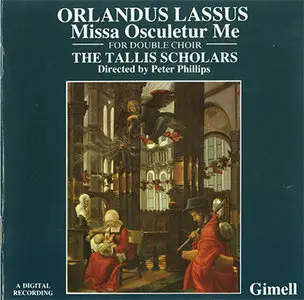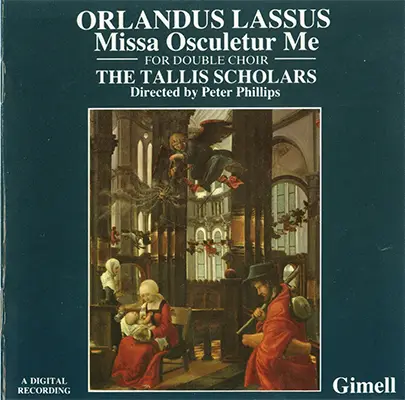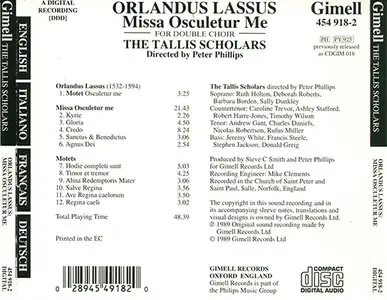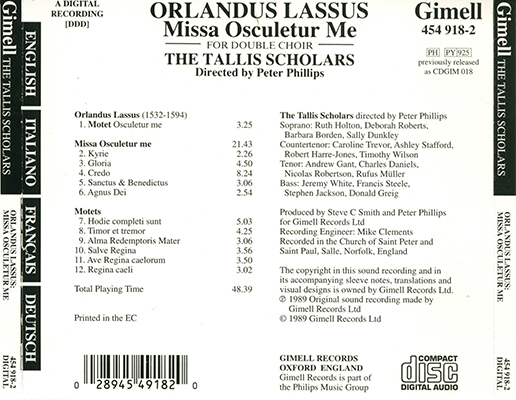The Tallis Scholars - Orlandus Lassus - Missa Osculetur Me
EAC+LOG+CUE | FLAC (tracks): 223 MB | Artwork | 5% Recovery Info
Label/Cat#: Gimell Records # 454 918-2 | Country/Year: Europe 1989
Genre: Classical | Style: Renaissance, Choral, Sacred
MD5 [X] CUE [X] LOG [X] INFO TEXT [X] ARTWORK [X]
my rip [ ] not my rip [X]
Exact Audio Copy V1.0 beta 1 from 15. November 2010
EAC extraction logfile from 5. February 2013, 22:59
The Tallis Scholars / Orlandus Lassus Missa Osculetur Me
Used drive : TSSTcorpCDDVDW TS-L633A Adapter: 3 ID: 0
Read mode : Secure
Utilize accurate stream : Yes
Defeat audio cache : Yes
Make use of C2 pointers : No
Read offset correction : 6
Overread into Lead-In and Lead-Out : No
Fill up missing offset samples with silence : Yes
Delete leading and trailing silent blocks : No
Null samples used in CRC calculations : Yes
Used interface : Installed external ASPI interface
Gap handling : Appended to previous track
Used output format : User Defined Encoder
Selected bitrate : 896 kBit/s
Quality : High
Add ID3 tag : No
Command line compressor : C:\Program Files\Exact Audio Copy\FLAC\FLAC.EXE
Additional command line options : -8 -V -T "ARTIST=%a" -T "TITLE=%t" -T "ALBUM=%g" -T "DATE=%y" -T "TRACKNUMBER=%n" -T "TOTALTRACKS=%x" -T "GENRE=%m" -T "ALBUMARTIST=%v" -T "ALBUM ARTIST=%v" -T "COMMENT=EAC Secure Mode, Test & Copy, AccurateRip, FLAC -8" %s
TOC of the extracted CD
Track | Start | Length | Start sector | End sector
––––––––––––––––––––––––––––-
1 | 0:00.33 | 3:27.07 | 33 | 15564
2 | 3:27.40 | 2:26.40 | 15565 | 26554
3 | 5:54.05 | 4:50.33 | 26555 | 48337
4 | 10:44.38 | 8:24.40 | 48338 | 86177
5 | 19:09.03 | 3:05.70 | 86178 | 100122
6 | 22:14.73 | 2:58.45 | 100123 | 113517
7 | 25:13.43 | 5:03.25 | 113518 | 136267
8 | 30:16.68 | 4:25.37 | 136268 | 156179
9 | 34:42.30 | 3:06.40 | 156180 | 170169
10 | 37:48.70 | 3:57.48 | 170170 | 187992
11 | 41:46.43 | 3:50.15 | 187993 | 205257
12 | 45:36.58 | 3:02.50 | 205258 | 218957
Track 1
Filename C:\MY RIPS\01 - Osculetur me.wav
Pre-gap length 0:00:02.33
Peak level 68.4 %
Extraction speed 1.0 X
Track quality 100.0 %
Test CRC 52F7D9E8
Copy CRC 52F7D9E8
Accurately ripped (confidence 3) [50128F96]
Copy OK
Track 2
Filename C:\MY RIPS\02 - Kyrie.wav
Pre-gap length 0:00:01.35
Peak level 82.0 %
Extraction speed 1.0 X
Track quality 100.0 %
Test CRC CC47B74C
Copy CRC CC47B74C
Accurately ripped (confidence 3) [B126E94B]
Copy OK
Track 3
Filename C:\MY RIPS\03 - Gloria.wav
Peak level 83.8 %
Extraction speed 1.1 X
Track quality 99.9 %
Test CRC D42AD67E
Copy CRC D42AD67E
Accurately ripped (confidence 3) [161BA91F]
Copy OK
Track 4
Filename C:\MY RIPS\04 - Credo.wav
Peak level 76.3 %
Extraction speed 1.4 X
Track quality 99.9 %
Test CRC 5C8CCEDA
Copy CRC 5C8CCEDA
Accurately ripped (confidence 3) [07047DFB]
Copy OK
Track 5
Filename C:\MY RIPS\05 - Sanctus and Benedictus.wav
Peak level 88.9 %
Extraction speed 1.2 X
Track quality 99.9 %
Test CRC 6AB3B0F1
Copy CRC 6AB3B0F1
Accurately ripped (confidence 3) [C1B21A5B]
Copy OK
Track 6
Filename C:\MY RIPS\06 - Agnus Dei.wav
Peak level 48.6 %
Extraction speed 1.5 X
Track quality 100.0 %
Test CRC E3853747
Copy CRC E3853747
Accurately ripped (confidence 3) [CE14A6B5]
Copy OK
Track 7
Filename C:\MY RIPS\07 - Hodie completi sunt.wav
Pre-gap length 0:00:04.30
Peak level 43.0 %
Extraction speed 1.7 X
Track quality 100.0 %
Test CRC 0C1204DE
Copy CRC 0C1204DE
Accurately ripped (confidence 3) [8737F295]
Copy OK
Track 8
Filename C:\MY RIPS\08 - Timor et tremor.wav
Peak level 95.5 %
Extraction speed 1.7 X
Track quality 100.0 %
Test CRC E44167C4
Copy CRC E44167C4
Accurately ripped (confidence 3) [03CA9FA7]
Copy OK
Track 9
Filename C:\MY RIPS\09 - Alma Redemptoris Mater.wav
Peak level 72.3 %
Extraction speed 1.7 X
Track quality 100.0 %
Test CRC F4CA8F1B
Copy CRC F4CA8F1B
Accurately ripped (confidence 3) [E287C56C]
Copy OK
Track 10
Filename C:\MY RIPS\10 - Salve Regina.wav
Peak level 75.2 %
Extraction speed 1.8 X
Track quality 100.0 %
Test CRC 40F745CA
Copy CRC 40F745CA
Accurately ripped (confidence 3) [1B35B6C3]
Copy OK
Track 11
Filename C:\MY RIPS\11 - Ave Regina caelorum.wav
Pre-gap length 0:00:00.70
Peak level 64.9 %
Extraction speed 1.9 X
Track quality 100.0 %
Test CRC 03E6E8E1
Copy CRC 03E6E8E1
Accurately ripped (confidence 3) [A73A246A]
Copy OK
Track 12
Filename C:\MY RIPS\12 - Regina caeli.wav
Peak level 53.7 %
Extraction speed 1.8 X
Track quality 100.0 %
Test CRC 37E487A8
Copy CRC 37E487A8
Accurately ripped (confidence 3) [C0D855CF]
Copy OK
All tracks accurately ripped
No errors occurred
End of status report
==== Log checksum 7FA762B3B7AE824C16679F13D5F54605BEE184CD96A4B646E23D342E50C5D454 ====
EAC extraction logfile from 5. February 2013, 22:59
The Tallis Scholars / Orlandus Lassus Missa Osculetur Me
Used drive : TSSTcorpCDDVDW TS-L633A Adapter: 3 ID: 0
Read mode : Secure
Utilize accurate stream : Yes
Defeat audio cache : Yes
Make use of C2 pointers : No
Read offset correction : 6
Overread into Lead-In and Lead-Out : No
Fill up missing offset samples with silence : Yes
Delete leading and trailing silent blocks : No
Null samples used in CRC calculations : Yes
Used interface : Installed external ASPI interface
Gap handling : Appended to previous track
Used output format : User Defined Encoder
Selected bitrate : 896 kBit/s
Quality : High
Add ID3 tag : No
Command line compressor : C:\Program Files\Exact Audio Copy\FLAC\FLAC.EXE
Additional command line options : -8 -V -T "ARTIST=%a" -T "TITLE=%t" -T "ALBUM=%g" -T "DATE=%y" -T "TRACKNUMBER=%n" -T "TOTALTRACKS=%x" -T "GENRE=%m" -T "ALBUMARTIST=%v" -T "ALBUM ARTIST=%v" -T "COMMENT=EAC Secure Mode, Test & Copy, AccurateRip, FLAC -8" %s
TOC of the extracted CD
Track | Start | Length | Start sector | End sector
––––––––––––––––––––––––––––-
1 | 0:00.33 | 3:27.07 | 33 | 15564
2 | 3:27.40 | 2:26.40 | 15565 | 26554
3 | 5:54.05 | 4:50.33 | 26555 | 48337
4 | 10:44.38 | 8:24.40 | 48338 | 86177
5 | 19:09.03 | 3:05.70 | 86178 | 100122
6 | 22:14.73 | 2:58.45 | 100123 | 113517
7 | 25:13.43 | 5:03.25 | 113518 | 136267
8 | 30:16.68 | 4:25.37 | 136268 | 156179
9 | 34:42.30 | 3:06.40 | 156180 | 170169
10 | 37:48.70 | 3:57.48 | 170170 | 187992
11 | 41:46.43 | 3:50.15 | 187993 | 205257
12 | 45:36.58 | 3:02.50 | 205258 | 218957
Track 1
Filename C:\MY RIPS\01 - Osculetur me.wav
Pre-gap length 0:00:02.33
Peak level 68.4 %
Extraction speed 1.0 X
Track quality 100.0 %
Test CRC 52F7D9E8
Copy CRC 52F7D9E8
Accurately ripped (confidence 3) [50128F96]
Copy OK
Track 2
Filename C:\MY RIPS\02 - Kyrie.wav
Pre-gap length 0:00:01.35
Peak level 82.0 %
Extraction speed 1.0 X
Track quality 100.0 %
Test CRC CC47B74C
Copy CRC CC47B74C
Accurately ripped (confidence 3) [B126E94B]
Copy OK
Track 3
Filename C:\MY RIPS\03 - Gloria.wav
Peak level 83.8 %
Extraction speed 1.1 X
Track quality 99.9 %
Test CRC D42AD67E
Copy CRC D42AD67E
Accurately ripped (confidence 3) [161BA91F]
Copy OK
Track 4
Filename C:\MY RIPS\04 - Credo.wav
Peak level 76.3 %
Extraction speed 1.4 X
Track quality 99.9 %
Test CRC 5C8CCEDA
Copy CRC 5C8CCEDA
Accurately ripped (confidence 3) [07047DFB]
Copy OK
Track 5
Filename C:\MY RIPS\05 - Sanctus and Benedictus.wav
Peak level 88.9 %
Extraction speed 1.2 X
Track quality 99.9 %
Test CRC 6AB3B0F1
Copy CRC 6AB3B0F1
Accurately ripped (confidence 3) [C1B21A5B]
Copy OK
Track 6
Filename C:\MY RIPS\06 - Agnus Dei.wav
Peak level 48.6 %
Extraction speed 1.5 X
Track quality 100.0 %
Test CRC E3853747
Copy CRC E3853747
Accurately ripped (confidence 3) [CE14A6B5]
Copy OK
Track 7
Filename C:\MY RIPS\07 - Hodie completi sunt.wav
Pre-gap length 0:00:04.30
Peak level 43.0 %
Extraction speed 1.7 X
Track quality 100.0 %
Test CRC 0C1204DE
Copy CRC 0C1204DE
Accurately ripped (confidence 3) [8737F295]
Copy OK
Track 8
Filename C:\MY RIPS\08 - Timor et tremor.wav
Peak level 95.5 %
Extraction speed 1.7 X
Track quality 100.0 %
Test CRC E44167C4
Copy CRC E44167C4
Accurately ripped (confidence 3) [03CA9FA7]
Copy OK
Track 9
Filename C:\MY RIPS\09 - Alma Redemptoris Mater.wav
Peak level 72.3 %
Extraction speed 1.7 X
Track quality 100.0 %
Test CRC F4CA8F1B
Copy CRC F4CA8F1B
Accurately ripped (confidence 3) [E287C56C]
Copy OK
Track 10
Filename C:\MY RIPS\10 - Salve Regina.wav
Peak level 75.2 %
Extraction speed 1.8 X
Track quality 100.0 %
Test CRC 40F745CA
Copy CRC 40F745CA
Accurately ripped (confidence 3) [1B35B6C3]
Copy OK
Track 11
Filename C:\MY RIPS\11 - Ave Regina caelorum.wav
Pre-gap length 0:00:00.70
Peak level 64.9 %
Extraction speed 1.9 X
Track quality 100.0 %
Test CRC 03E6E8E1
Copy CRC 03E6E8E1
Accurately ripped (confidence 3) [A73A246A]
Copy OK
Track 12
Filename C:\MY RIPS\12 - Regina caeli.wav
Peak level 53.7 %
Extraction speed 1.8 X
Track quality 100.0 %
Test CRC 37E487A8
Copy CRC 37E487A8
Accurately ripped (confidence 3) [C0D855CF]
Copy OK
All tracks accurately ripped
No errors occurred
End of status report
==== Log checksum 7FA762B3B7AE824C16679F13D5F54605BEE184CD96A4B646E23D342E50C5D454 ====
foobar2000 1.1.14a / Dynamic Range Meter 1.1.1
log date: 2014-10-18 16:03:42
––––––––––––––––––––––––––––––––––––––––
Analyzed: The Tallis Scholars / Orlandus Lassus Missa Osculetur Me
––––––––––––––––––––––––––––––––––––––––
DR Peak RMS Duration Track
––––––––––––––––––––––––––––––––––––––––
DR12 -3.29 dB -20.97 dB 3:27 01-Osculetur me
DR12 -1.72 dB -19.67 dB 2:27 02-Kyrie
DR13 -1.53 dB -20.29 dB 4:50 03-Gloria
DR14 -2.34 dB -21.48 dB 8:25 04-Credo
DR13 -1.01 dB -20.75 dB 3:06 05-Sanctus and Benedictus
DR12 -6.26 dB -23.45 dB 2:59 06-Agnus Dei
DR12 -7.31 dB -23.56 dB 5:03 07-Hodie completi sunt
DR15 -0.40 dB -23.43 dB 4:25 08-Timor et tremor
DR11 -2.81 dB -20.74 dB 3:07 09-Alma Redemptoris Mater
DR13 -2.47 dB -21.94 dB 3:58 10-Salve Regina
DR13 -3.75 dB -25.23 dB 3:50 11-Ave Regina caelorum
DR13 -5.40 dB -23.64 dB 3:03 12-Regina caeli
––––––––––––––––––––––––––––––––––––––––
Number of tracks: 12
Official DR value: DR13
Samplerate: 44100 Hz
Channels: 2
Bits per sample: 16
Bitrate: 563 kbps
Codec: FLAC
================================================================================
log date: 2014-10-18 16:03:42
––––––––––––––––––––––––––––––––––––––––
Analyzed: The Tallis Scholars / Orlandus Lassus Missa Osculetur Me
––––––––––––––––––––––––––––––––––––––––
DR Peak RMS Duration Track
––––––––––––––––––––––––––––––––––––––––
DR12 -3.29 dB -20.97 dB 3:27 01-Osculetur me
DR12 -1.72 dB -19.67 dB 2:27 02-Kyrie
DR13 -1.53 dB -20.29 dB 4:50 03-Gloria
DR14 -2.34 dB -21.48 dB 8:25 04-Credo
DR13 -1.01 dB -20.75 dB 3:06 05-Sanctus and Benedictus
DR12 -6.26 dB -23.45 dB 2:59 06-Agnus Dei
DR12 -7.31 dB -23.56 dB 5:03 07-Hodie completi sunt
DR15 -0.40 dB -23.43 dB 4:25 08-Timor et tremor
DR11 -2.81 dB -20.74 dB 3:07 09-Alma Redemptoris Mater
DR13 -2.47 dB -21.94 dB 3:58 10-Salve Regina
DR13 -3.75 dB -25.23 dB 3:50 11-Ave Regina caelorum
DR13 -5.40 dB -23.64 dB 3:03 12-Regina caeli
––––––––––––––––––––––––––––––––––––––––
Number of tracks: 12
Official DR value: DR13
Samplerate: 44100 Hz
Channels: 2
Bits per sample: 16
Bitrate: 563 kbps
Codec: FLAC
================================================================================
CD Info:
Orlandus Lassus - Missa Osculetur Me
The Tallis Scholars / Peter Philips
Label: Gimell Records, Philips
Catalog#: 454 918-2
Format: CD, Album
Country: Europe
Released: 1989
Genre: Classical
Style: Renaissance, Choral, Sacred
Tracklist:
Motet
1. Osculetur me
Missa Osculetur me
2. Kyrie
3. Gloria
4. Credo
5. Sanctus And Benedictus
6. Agnus Dei
Motets
7. Hodie completi sunt
8. Timor et tremor
9. Alma Redemptoris Mater
10. Salve Regina
11. Ave Regina caelorum
12. Regina caeli
The Tallis Scholars
Directed by Peter Philips
Although Orlandus Lassus (1532-1594) is perhaps the most celebrated late Renaissance composer, the few recordings of his music do not give an adequate impression of his achievement. His output was so diverse and so prolific it is hard to know where to begin. For the sacred music enthusiast, the obvious place is his Mass-settings, though these have long been considered inferior works. There is some truth in this point of view where Lassus' early four-part settings are concerned; but the later six- and eight-voiced settings are as fine as any of the period. Indeed there is a wealth of material yet to be explored in this category of Lassus' writing, and I believe that the three double-choir Masses will come to be seen as the most challenging pieces in it. These are Bell'Amfitrit'altera, Vinum bonum and Osculetur me.
Lassus must have learnt the technique of writing double-choir antiphonal music in Italy, since he would not have come across this method of text-setting in his native Flanders. Flemish composers held uninterrupted counterpoint (and especially eight-part counterpoint) to be the highest art; there is no double-choir music by Flemish composers who stayed in Flanders from this period, though there are examples of eight-part music (one of the finest being Clemens' Pater peccavi, recorded on CDGIM 013 ). This style of writing, which leads to the most subtle and intimate expression, is at the opposite extreme from most antiphonal music, which aims to impress the listener by sheer size. In musical terms the difference between them is between music conceived horizontally, which is the essence of counterpoint, and vertically, as with most Italian Baroque music. However even here it is difficult to make generalisations about Lassus: while the Mass and motet Osculetur me fall into the latter category, many of the other pieces recorded here come into the former.
The danger with double-choir writing is that its massive effects can lose their power for the listener after the first hearing. This is often the case with the first Venetian experiments in the form, and, in overcoming this problem, Lassus holds an important place in the early development of Italian Baroque style. Osculetur me is a fine example of how he turned this new method of composition to his own ends, possibly acting as a model even to the Venetian composer Andrea Gabrieli, who visited him in Munich in the 1560s.
In the motet Osculetur me the main strengths of the Mass are already apparent: quite long phrases for each choir, so that brief counterpoint is possible; a strong difference in sonority between passages for one choir and those for both choirs together (not always the case in Venetian music of this period); a succession of phrases which have audibly contrasting moods and contours (for instance the sensuous writing at 'oleum effusum nomen tuum' and the close antiphony of 'Trahe me post te'). The advantage is that while in the motet these contrasts are suggested by the words, when he came to set the Mass Lassus had a powerful set of motifs to distribute about the text. The antiphony already described at 'Trahe me post te' is superbly used in almost every movement of the Mass, and never better than in the second 'Kyrie' where Lassus unexpectedly raised the final statement a third, even thinking to syncopate the soprano entry. Elsewhere he showed that he could, just as well as Palestrina, rewrite or extend the music of his model in the most sophisticated parody treatment. The quartet that begins at 'Crucifixus' is the most remarkable example; but the opening bars of the 'Sanctus' and the 'Agnus Dei' show the same technique. The 'Benedictus' seems to be newly composed altogether.
Of the motets recorded here the Salve regina belongs to the same musical tradition as Osculetur me. The power of this setting relies more than usual with Lassus on the underlying harmony (for instance the suspensions on 'O clemens'). Alma Redemptoris Mater also makes use of the double-choir arrangement, though in fact the piece comes close at times to the Flemish tradition of eight-part counterpoint, with its characteristic intimacy. The two other Marian motets, Ave Regina caelorum and Regina caeli, are in six and seven parts respectively and must count among Lassus' finest achievements. Hodie completi sunt, in six parts, is an intense contrapuntal piece, sung here by men's voices at written pitch, though there would be a case for transposing it up and using sopranos. It has two halves which are linked by common material for the word 'Alleluia'. Timor et tremor is justly famed for its extraordinary chromatic language. Written in six parts, it was orginally published in 1564 as part of an anthology entitled 'Thesaurus Musicus'. It is not the only early work by Lassus to explore the chromatic scale (the Prophetiae Sibyllarum come from the same period), but since they predate Gesualdo's similar experiments by several decades it is strange that Lassus made almost no further use of these otherworldly and fascinating sounds in his compositions. Timor et tremor is one of the most compact of all Renaissance chromatic motets, finishing with breathtaking syncopation in the first soprano part.
© 1989 Peter Phillips
Thanks to miloslav2011!
The Tallis Scholars - Jacob Obrecht - Missa Maria Zart
The Tallis Scholars - Sing Thomas Tallis
The Tallis Scholars - Sing Palestrina
The Tallis Scholars - Requiem
The Tallis Scholars - Sing William Byrd
The Tallis Scholars - Josquin ...Lingua / Missa La Sol Fa Re Mi
The Tallis Scholars - Sarum Ch...licantu / the Mass at Cockcrow
all of my uploads in my blog







